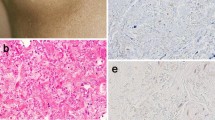Summary
Tenascin is an extra cellular matrix glycoprotein which is distributed in the mesenchyme surrounding various organs during embryogenesis. It has also been demonstrated in some normal adult tissues and in the matrix of human tumours. The present study has been carried out to analyse the distribution of tenascin in non malignant and malignant skin disorders, in squamous cell carcinomas of the head and neck, in squamous cell carcinoma xenografts and in a squamous cell carcinoma cell line grown on collagen gel. Immunohisto-chemical localisation of tenascin was performed, using a monoclonal antibody specific for tenascin, by the indirect immunoperoxidase method with silver enhancement. Tenascin was heterogeneously distributed in the extra cellular matrix of squamous cell carcinomas and in squamous cell carcinoma xenografts. It was absent in basal cell carcinoma and in the squamous cell carcinoma cell line grown on collagen gel. The distribution of tenascin in squamous cell carcinoma and basal cell carcinoma is discussed in relation to tumour invasion and differentiation.
Similar content being viewed by others
References
Aufderheide E, Chiquet-Erishman R, Ekblom P (1987) Epithelial-mesenchymal in the developing kidney lead to expression of tenascin in the mesenchyme. J Cell Biol 105:599–608
Aufderheide E, Ekblom P (1988) Tenascin during gut development: Appearance in the mesenchyme, shift in molecular forms, and dependence on epithelial-mesenchymal interactions. J Cell Biol 107:2341–2349
Bourdon MA, Matthews TJ, Pizzo SV, Bigner DD (1985) Immuno-chemical and biochemical characterisation of a glioma-associated extra cellular matrix glycoprotein. J Cell Biochem 28:183–195
Burns J, Chan VTW, Jonasson JA, Fleming KA, Tailor S, O’D McGee J (1985) Sensitive system for visualising biotinylated DNA probes hybridised in situ: rapid sex determination of intact cells. J Clin Pathol 38:1085–1092
Chiquet M, Fambrough DM (1984) Chick myotendinous antigen I. A monoclonal antibody as a marker for tendon and muscle morphogenesis. J Cell Biol 98:1926–1936
Chiquet-Erishman R, Mackie JE, Pearson CA, Sakakura T (1986) Tenascin: an extra cellular matrix protein involved in tissue interactions during fetal development and oncogenesis. Cell 47:131–139
Easty DM, Easty GC, Carter RL, Monaghan P, Butler LJ (1981) Ten human carcinoma cell lines derived from squamous carcinoma of the head and neck. Br J Cancer 43:772–785
Erickson HP, Tailor HC (1987) Hexabrachion proteins in embryonic chicken tissues and human tumours. J Cell Biol 105:1387–1394
Grumet MS, Hoffman S, Crossin KL, Edelman GM (1985) Cytotactin, an extra cellular matrix protein of neural and non-neural tissues that mediates glia-neuron interaction. Proc Natl Acad Sci USA 82:8075–8079
Gusterson BA, Warburton MJ, Mitchell D, Kraft N, Hancock WW (1984) An immunohistochemical study using a monoclonal antibody to type IV collagen. Lab Invest 51:82–87
Gusterson BA, Clinton S, Gough G (1986) Studies of early invasive and intra epithelial squamous cell carcinomas using an antibody to type IV collagen. Histophathology 10:161–169
Gusterson BA, Carter RL, Warburton MJ, Fisher C (1988) Is loss of basement membrane important for invasion? Eur Urol 14(1): 2–3
Inaguma Y, Kusakabe M, Mackie EJ, Pearson CA, Chiquet-Erishman R, Sakakura T (1988) Epithelial induction of stromal tenascin in the mouse mammary gland: from embryogenesis to carcinogenesis. Dev Biol 128:245–255
Jones FS, Burgoon MP, Hoffman S, Crossin KL, Cunningham BA, Edelman GM (1988) A cDNA clone for cytotactin contains sequences similar to epidermal growth factor like repeats and segments of fibronectin and fibrinogen. Proc Natl Acad Sci USA 85:2186–2190
Knight A, Gusterson BA, Cowley G, Monaghan P (1984) Differentiation of normal and malignant human squamous epithelium in vivo and in vitro: A morphologic study. Ultrastruct Pathol 7:133–141
Kruse J, Keilhauer G, Faissner A, Timpl R, Schachner M (1985) A novel nervous system cell adhesion molecule of the L2/HNK-1 family. Nature (Lond) 316:146–148
Libermann TA, Nusbaum HR, Razon N, Kris R, Lax I, Soreq H, Whittle N, Waterfield MD, Ullrich A, Schlessinger J (1985) Amplification, enhanced expression and possible rearrangement of EGF receptor gene in primary human brain tumours of glial origin. Nature (Lond) 313:144–147
Lightner VA, Gumkowski F, Bigner DD, Erickson HP (1989) Tenascin/Hexabrachion in the human skin: Biochemical identification and localisation by light and electron microscopy. J Cell Biol 108:2483–2493
Mackie EJ, Chiquet-Erishman R, Pearson CA, Inaguma Y, Taya K, Kawarda Y, Sakakura T (1987a) Tenascin is a stromal marker for epithelial malignancy in mammary gland. Proc Natl Acad Sci USA 84:4621–4625
Mackie EJ, Thesleff I, Chiquet-Erishman R (1987b) Tenascin is associated with chondrogenic and osteogenic differentiation in vivo and promotes chondrogenesis in vitro. J Cell Biol 102:2569–2579
Mackie EJ, Tucker RP, Hafter W, Chiquet-Erishman R, Epperlein HH (1988a) The distribution of tenascin coincides with pathways of neural crest cell migration. Development 102:237–250
Mackie EJ, Halfter W, Liverani D (1988b) Induction of tenascin in healing wounds. J Cell Biol 107: 2757–2767
Mitchell D, Ibrahim S, Gusterson BA (1985) Improved immunohistochemical localisation of tissue antigens using modified methancarn fixation. J Histochem Cytochem 33:491–495
Spring J, Beck K, Chiquet-Ehrismann R (1989) Two contrary functions of tenascin: dissection of the active sites by recombinant tenascin fragments. Cell 59:325–334
Stamp WH (1989) Tenascin distribution in basal cell carcinomas. J Pathol 159:225–229
Vaughan L, Huber S, Chiquet M, Winterhalter KH (1987) A major, six-armed glycoprotein from embryonic cartilage. EMBO J 6:349–353
Author information
Authors and Affiliations
Rights and permissions
About this article
Cite this article
Anbazhagan, R., Sakakura, T. & Gusterson, B.A. The distribution of immuno-reactive tenascin in the epithelial-mesenchymal junctional areas of benign and malignant squamous epithelia. Virchows Archiv B Cell Pathol 59, 59–63 (1990). https://doi.org/10.1007/BF02899388
Received:
Accepted:
Issue Date:
DOI: https://doi.org/10.1007/BF02899388




